

Churches

The Church was the center of public life in the colonies.

The tower held the bell at the Lutheran Church in Kukkus, which provided the news updates of births, deaths, and church services of the villagers when it tolled.
"Generally speaking, there were no theaters, libraries, movies, taverns, restaurants, hotels, sports events.... Aside from the occasional town meeting, the only public gatherings were church services, prayer meetings, ...the occasional wedding celebration or funeral service and of course public markets...."
Fred C. Koch, 1977. The Volga Germans, pg. 129

The Church was the center of public life for the immigrants.
"Almost their entire social life in Fresno was centered around the church. They would spend Sunday morning in Sunday school, the afternoon in fellowship and the evening in church, as well as Monday night and Wednesday night. And the men would have fellowship on Saturdays."
Dr. Norman Bitter, son of one of the later immigrants to arrive in Fresno from Russia, spoke of the Volga Germans, ARCHITECTURAL RESOURCES GROUP, Architects, Planners & Conservators, Inc., GERMANTOWN, FRESNO, HISTORICAL CONTEXT, 4 APRIL 2006

Original Cross Church, Fresno, CA, constructed in 1895 (photograph courtesy of AHSGRFR).
Religion
Excerpt from: ARCHITECTURAL RESOURCES GROUP, Architects, Planners & Conservators, Inc., GERMANTOWN, FRESNO HISTORICAL CONTEXT 4 APRIL 2006
The Volga Germans generally continued to practice the same religion to which they had adhered while living in Germany. “Of the 104 colonies established from 1764 to 1768 there were 29 Catholic colonies and 75 Protestant settlements.”29 Catherine II insisted that the villages be comprised of Germans who shared the same religious beliefs in order to avoid ideological clashes. This settlement approach was successful and the area remained strife-free. Of the Protestant wing of Christianity, the Lutheran Church was the most prevalent with seventy-eight percent of the members. Twenty-two percent of Protestants were members of the Reformed Church.30 Carl J. Meier, former pastor of the Free Evangelical Lutheran Cross Church, writes: “There were 104 churches in 22 parishes with 259,656 members on the ‘Wiesenseite’ or meadow of the Volga River,” where most of the immigrants who would later settle in Fresno lived.31 Catherine II promised the Germans religious freedom if they moved to Russia. When Catherine II sent forth an edict forcing the Volga Germans into military duty, the Volga Germans viewed this as an attack on their religious freedom, as many of them were pacifists. Thus, when the opportunity arose to move to the United States and enjoy its religious and political freedom, the Volga Germans packed their belongings and embarked on the long journey.
The Volga German settlement in Fresno, California, was comprised mostly of Lutheran Protestant Evangelicals. Among the few possessions they were able to carry with them to the United States, many of the new immigrants brought copies of the Bible, a prayer book, and the Catechism. After settling in Fresno, religion continued to play a dominant role in the lives of the Volga Germans. The early pioneers hosted prayer meetings in their residences from 1887 until 1891. Soon, the German-Russians decided to organize a formal church. A parochial teacher living in Straub, Russia named Jacob Legler, was asked to move to Fresno to oversee the organization of the new church. Legler and his family arrived in Fresno in 1891, and he was ordained as a minister shortly thereafter. Legler initially conducted services in the local Armenian Hall. On March 15, 1892, Fresno’s first Volga German church, the Cross Church, was officially organized with 85 charter members. Mennonite Volga Germans settled mostly in the Reedley area of Fresno County.
Church Architecture
Almost all Lutheran and Reformed churches on the Volga were constructed in the village and city colonies at the same time. These were massive new buildings which were built in the same style and by the same architects and builders and so this style is referred to as the kontor or bureaucratic style.32
The church had three bells of different sizes, which were rung each evening at seven o’ clock. They served to call people to worship; to announce a death in the village-- often telling the age of the deceased by measured toll; to announce a fire; and it rang for hours at a time to guide persons to the village who might be lost in a storm.33
Several villages on the banks of the Volga River were combined to form single parishes. The villages of Straub and Stahl, from which most of the original Volga German settlers in Fresno derived, were located within the Privalnoje (Warenberg) parish. The oldest standing church in this parish is in the village of Warenberg, just south of Straub. Constructed in 1843, the Warenberg Church (see Figure N) is visually quite similar to the Free Evangelical Lutheran Cross Church in Fresno, constructed in 1915 (see Figure Q).
Historical photographs of churches in Norka, Jost, and Straub depict similar designs. According to the Volga German website:
All the churches had cross-shaped plans. The main entrance was typically distinguished by a grand pedimented portico supported by Doric columns. There were usually two side entrances at the transept with pedimented porticos. Most churches had apse extensions at the rear. The character-defining feature of Kontor style churches is a multi-storied bell tower, square in plan, located at the front of the church. All historic photographs of churches on the Wiesensite of the Volga River region depict a dome cap on top of all the bell towers. Crosses were mounted to the top of the domes.
This tradition was carried to Fresno by the Volga Germans. “The churches…told the community when someone died, tolling the bells nine times for an older person, six times for a younger one, and three times for a child.”34 According to local lore, twelve Volga German churches existed at the same time in Germantown.
Cross Church, Fresno
In Fresno one of the first major building projects undertaken by the German-Russians was a church. On April 7, 1894, members of the future Cross Church voted to build a church on lots 25 and 26 of block 223 in the center of F Street.35 The first Volga German church was erected in Fresno, California, in 1895. The construction of the Cross Church was funded through donations and cost $1,077.80. The church was designed in a simplified version of the Kontor style. “The churches of the Volga Germans in the U.S.A. are also variously patterned after those of the old homeland. Especially striking examples are the two Evangelical churches in Lincoln, Nebraska, [and] one in Fresno, California…”36 The characteristic bell tower and pedimented entry were included in the simple design of the Cross Church, yet hardly as ornate and massive as the Kontor originals in Russia.
As the German-Russian population increased, the congregation eventually outgrew the small church on F Street, and a new building was erected in 1915 for a cost of $27,046.24. This building closely resembled the Kontor style churches in Russia in both ornamentation and massing. Characteristic of Kontor style churches, the Free Evangelical Lutheran Cross Church has a cross-shaped plan, a stately pedimented portico (main entry), and a tall bell tower capped by a rounded dome. Members of the Cross Church were informed in 1947 that Highway 99 would be constructed over the site of the church and the congregation was forced to have the church moved or it would be demolished. On November 3, 1947, the 62’x130’ church was moved off its foundation. The move took 22 men and cost $66,700. This building served as Fresno’s main German-Russian church from 1914 until it was sold in 1966. The church is now known as Fresno Temple Church of God.
St. Paul’s Evangelical Lutheran Church, Fresno
Located on California and Lotus Avenue, St. Paul’s Evangelical Church was dedicated in 1913. Carl Legler, son of Jacob Legler, the first pastor of Cross Church, was the original pastor. St. Paul’s Church did not follow the pattern of the Kontor style churches, yet resembled churches from the west side of the Volga River (villages such as Kamenka and Messer). The design is a simple rectangular plan with minimal ornamentation. A square bell tower was located at the front of the church, with the main entry at the lower story of the tower. The top of the bell tower was not rounded, as in the Kontor tradition, but instead rose into a sharp pyramidal cap. The Gothic arch shape was dominant and found in fenestration and vent openings that punctuated the bell tower.
Other Fresno German-Russian Churches
According to the 1937 city directory, the following German-Russian churches (besides Cross Church and St. Paul’s) existed at that time: Zion Congregational (Monterey & E), Church of God (Los Angeles & E), Emmanuel Baptist (Lorena & Kirk), Third Congregational (San Benito & E), Wartburg Evangelical (Ventura & D), and Seventh Day Adventist (California & B).37

Figure N: Warenberg Church, Warenberg, Russia (photograph courtesy of VolgaGermans.net).

Figure O: Church in Norka, Russia (photo- graph courtesy of VolgaGermans.net).

Figure P: Original Cross Church, Fresno, CA, constructed in 1895 (photograph courtesy of AHSGRFR).

Figure Q: Free Evangelical Lutheran Cross Church, Fresno, CA, constructed in 1914 (photograph courtesy of AHSGRFR).

Figure R: St. Paul’s Evangelical Lutheran Church, Fresno, CA, c. 1913 (photograph courtesy of AHSGRFR).
RESOURCES:
29 Meier, Carl J. “80th Anniversary of the Free Evangelical Lutheran Cross Church of Fresno, California.” Unpublished Manuscripts from the American Historical Society of Germans from Russia Library. n.d.: 6.
30 Meier, 8.
31 ibid.
32 VolgaGermans.net (accessed August 2005).
33 ibid.
34 Golston, Jacalyn. “The Germans: From Russia They Came.” The Fresno Bee. 10 February 1980: n. pag.
35 Meier, 47.
36 Gallup, Aaron. Supplemental Historic Architecture Survey Report for Highway 41 Construction in the City of Fresno. Unpublished manuscripts from the City of Fresno Planning Department. June 1991: 5.
37 Unpublished manuscripts from the City of Fresno Planning Department. n.d: n. pag.
SOURCE:
ARCHITECTURAL RESOURCES GROUP, Architects, Planners & Conservators, Inc., GERMANTOWN, FRESNO HISTORICAL CONTEXT 4 APRIL 2006
Want more of the story?
The City of Fresno Planning and Development Department
Use following link to view and download the entire publication:
Churches in Russia
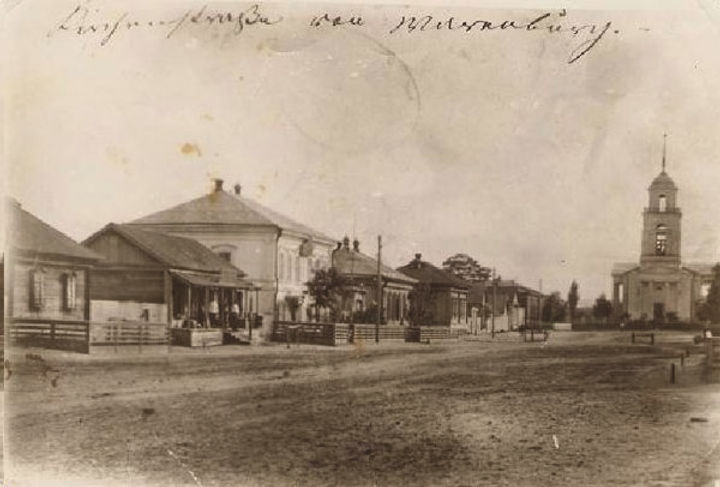
Street in Warenburg (Compliments of Dr Brent Mai, Volga German Institute)
Parishioners between 1905 and 1907 constructed the Warenburg Lutheran Church pictured above. The villagers of Warenburg built the original Warenburg Lutheran Church in 1770.
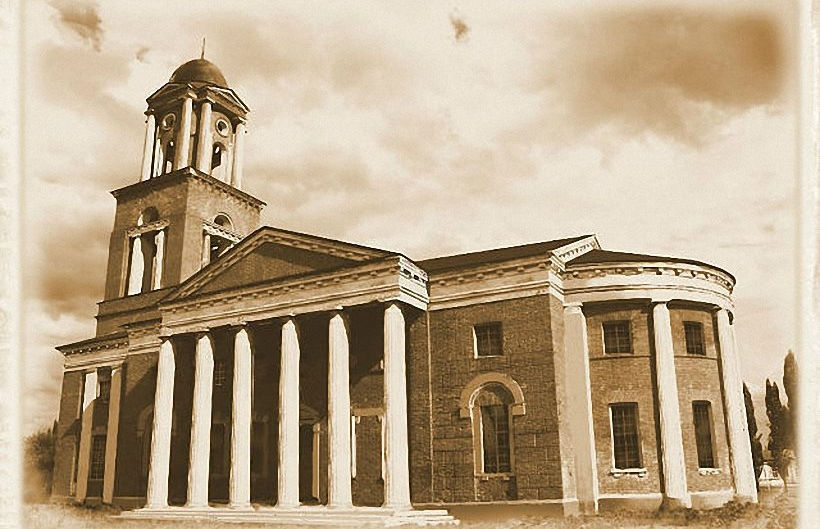
Warenburg Lutheran Church
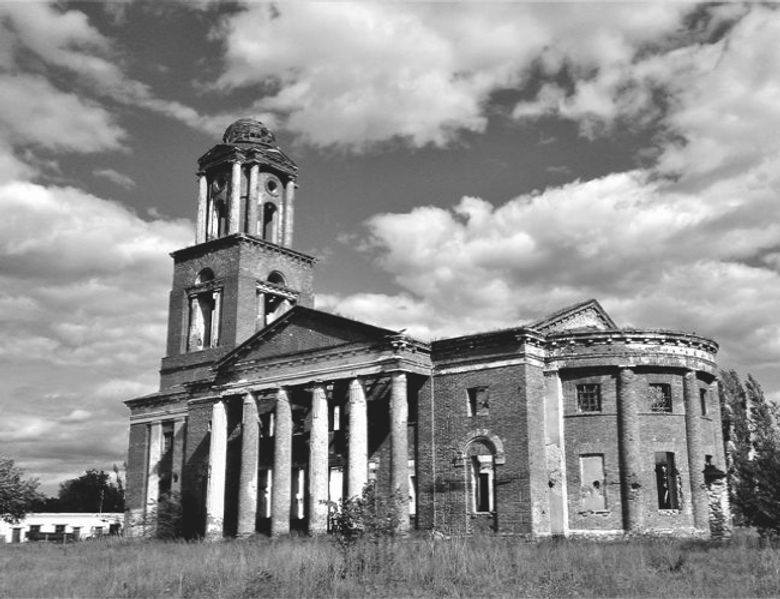
The Warenburg Lutheran Church church was used later as a tractor repair shop (in the narthex) and a youth gathering facility.

The Church in Straub displayed the Kontor Style of architecture that was common for many Volga German churches.
The Church in Straub
The Bangert Church as it appears in 1911 photo


Dobrinka Lutheran Church
The Dobrinka Lutheran Church has been allowed to decay into near-complete destruction.

Church interior panorama
Volga German churches had balconies that were sometimes on each side of the bustling and at times entirely around the perimeter of the church.
Regional Churches

The original church organizational structure was not sufficient to keep everyone happy. In 1900 the Lutheran Cross Church began independent services. On March 12, 1900, Zion Congregational was organized.
In 1907 the Third Congregational church was formed. In 1929, during the Depression, a new building was established at San Benito and E Streets.
The religious harmony that the Germans had enjoyed in the Russian villages did not last long. According to the The Fresno Bee, in October of 1935, “Schisms with the membership”, created by a dual Lutheran-Congregational arrangement brought about the establishment of Zion Congregational in 1900 and St. Paul’s Evangelical in 1912.
In 1922 members of the Lutheran Cross Church established the Biola Church and the Salem Congregational Church on McCall Avenue near Sanger.

Lutheran Churches in the 30s and 40s
Biola Congregational Church
4717 N 5th Ave, Biola, CA 93606
Biola Congregational website: https://www.biolacongregationalchurch.com/
Biola Congregational Church was founded by Volga German families in 1921. The nucleus of the congregation maintains their culinary culture by making and selling kuchen. The church has a rich history in the local community.


Biola Congregational Church is home to many generations of German-Russian families.


The Fresno Bee-17 June 1934


The Fresno Bee the Republican- 1933
St. Paul's Lutheran Church

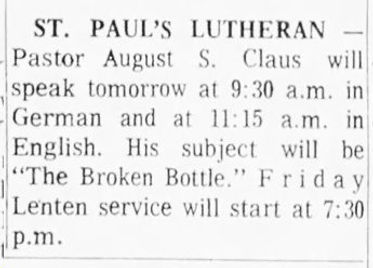
The Fresno Bee-March 7, 1970
Services were delivered in German and English into the ‘70s.
The Fresno Bee-March 7, 1970
Wartburg Lutheran Church
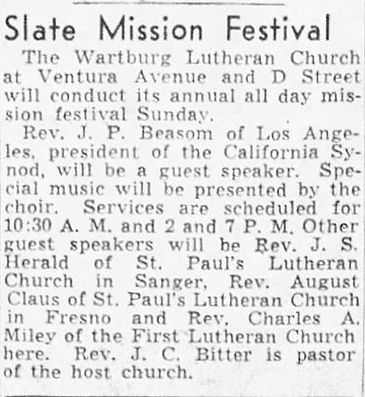
November 2, 1945
Zion Congregational Church
In the fall of 1899, a small group gathered in a house on "G" Street in Fresno. A few weeks later, the meetings were moved to the Armenian Social Hall. On 12 March 1900, thirty-eight of those gathered decided officially to organize a congregation under the name of the Evangelical Zion Congregational Church. Most of them were Lutheran, but it was the German Congregational Conference that was able to assist with the building of a church building, so they joined that group.
The first building was on the corner of E and Monterey Streets. The corner stone was laid on 18 February 1900 and the completed building dedicated later that spring.
In 1930, this building was torn down to make room for a new building. It was completed on 4 December 1931. The name of the congregation was changed to Zion Congregational Church. The last service in this building was held on 12 July 1959. The facility was sold to a Seventh Day Adventist congregation.
A new church was built at Sierra Vista & Yale. The first worship service held there was on 20 September 1959 with the formal dedication service held on 18 October 1959. The congregation became affiliated with the United Church of Christ.
This congregation has disbanded.
Original Location:
260 E Street
Fresno, California
Second Location:
4718 E Yale
Fresno, California
To view a list of Charter Members, Priests, and Pastors:
https://volga.domains.unf.edu/congregations/zion-congregational-church-fresno
Sources:
75th and 100th Anniversary booklets for the congregation
Volga German Institute at the University of North Florida



